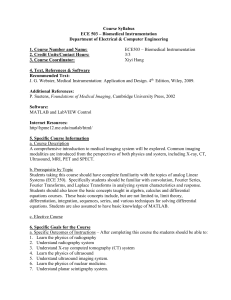Version - Word 124 KB - Department of Health
advertisement
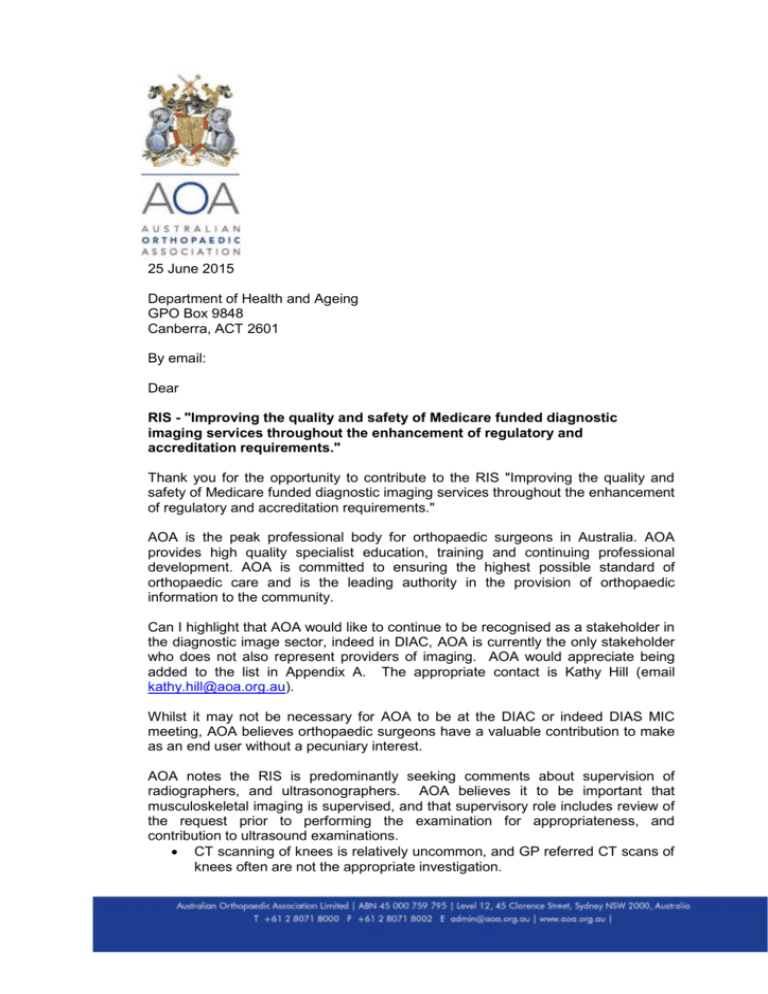
25 June 2015 Department of Health and Ageing GPO Box 9848 Canberra, ACT 2601 By email: Dear RIS - "Improving the quality and safety of Medicare funded diagnostic imaging services throughout the enhancement of regulatory and accreditation requirements." Thank you for the opportunity to contribute to the RIS "Improving the quality and safety of Medicare funded diagnostic imaging services throughout the enhancement of regulatory and accreditation requirements." AOA is the peak professional body for orthopaedic surgeons in Australia. AOA provides high quality specialist education, training and continuing professional development. AOA is committed to ensuring the highest possible standard of orthopaedic care and is the leading authority in the provision of orthopaedic information to the community. Can I highlight that AOA would like to continue to be recognised as a stakeholder in the diagnostic image sector, indeed in DIAC, AOA is currently the only stakeholder who does not also represent providers of imaging. AOA would appreciate being added to the list in Appendix A. The appropriate contact is Kathy Hill (email kathy.hill@aoa.org.au). Whilst it may not be necessary for AOA to be at the DIAC or indeed DIAS MIC meeting, AOA believes orthopaedic surgeons have a valuable contribution to make as an end user without a pecuniary interest. AOA notes the RIS is predominantly seeking comments about supervision of radiographers, and ultrasonographers. AOA believes it to be important that musculoskeletal imaging is supervised, and that supervisory role includes review of the request prior to performing the examination for appropriateness, and contribution to ultrasound examinations. CT scanning of knees is relatively uncommon, and GP referred CT scans of knees often are not the appropriate investigation. Ultrasound of the knee is not a particularly valuable test except perhaps to differentiate a ruptured Bakers cyst from a DVT. Ultrasound of the shoulder needs consultant radiologist involvement. Supervision of ultrasounds of neonatal hips requires dynamically testing the stability of the hip. Quality control of plain radiology is also a key component, and better images should be done immediately, without the patient needing recall to the radiology practice. Continuing to imbed the ATS 2014-5816 within DIAS is essential to provide diagnostic quality imaging for specialists who did not initially order the investigation. This avoids unnecessary duplication and radiation. The access to radiologists PACS through quality client software (eg Visage, and to a lesser extent Inteleviewer) allows better triaging of patients in overworked public clinics, in many instances GPs may be given advice on continuing to manage the patient rather than the patient being seen in a public clinic. Ultimately e-Health should be able to provide much of this functionality, although there is also value in consultants seeing imaging before the patient. Meanwhile, AOA could contribute in assessing whether radiology practices are providing the level of internet access required by surgeons and specialists in general. Yours sincerely, David Mitchell Chair AOA Digital Imaging Committee SUBMISSION FEEDBACK Please provide comments on all or any of the following, particularly in relation to each Option outlined in the Consultation Regulation Impact Statement: The appropriateness and feasibility of the proposals. Whether the proposed changes will address current concerns with the regulations in the diagnostic imaging sector. Potential costs associated with each option. Potential benefits associated with each option. Potential workforce impacts. Impacts on patient access to appropriate imaging. Rural and remote access for patients. Time required to implement the potential changes. Impact on both smaller diagnostic imaging practices and larger practices. Any other comments, questions and concerns that relate to the proposed options. In addition, you may wish to respond to questions listed against specific Options. Submissions should include substantiating evidence, where possible. Option 1 – No regulatory changes or deregulation (refer to page 23 of the RIS) Features: The current supervision requirements remain unchanged. The person under the professional supervision of the radiologist would require the appropriate qualifications, credentials, or training to provide the service. The current substitution rules in the Health Insurance Act 1973 remain. Rural and remote exemptions. Comment The AOA supports supervision of ultrasound, suggesting this option is best, but appreciates the other proposed changes in option 2 & 3 are appropriate. Option 2 – Minor changes including clarification of current requirements (refer to page 24-26 of the RIS) Features Amendments to the current supervision requirements to clarify the circumstances under which a radiologist and/or specialist or consultant physician must provide supervision and how the supervision must be provided. Professional supervision would require: the medical practitioner be available to observe and guide the conduct and diagnostic quality and safety of the examination and if necessary in accordance with accepted medical practice, attend the patient personally, within a reasonable period of time. The personal attendance requirement of musculoskeletal ultrasound would be amended to align with all other ultrasound items. The person under the professional supervision of the radiologist would require the appropriate qualifications, credentials, or training to provide the service. The current substitution rules in the Health Insurance Act 1973 remain. Rural and remote exemptions. Specified qualification requirements for ultrasound providers. Definition of diagnostic ultrasound. Comment The AOA does not support option 2, which reduces supervision of musculoskeletal ultrasound Musculoskeletal Ultrasound (refer to page 25-26 of the RIS) Questions: Are the principles as outlined satisfactory to clarify the requirements? What reasons, if any, are there for the personal attendance requirements for musculoskeletal ultrasound to remain? Would a minimum set of guidelines for ‘accepted medical practice’ per modality be appropriate? What savings are anticipated to be realised from removing the personal attendance requirements for musculoskeletal ultrasound services? What additional costs are anticipated to be incurred by requiring a medical practitioner (eg radiologist) to be in close proximity to attend on a patient personally within a reasonable period of time in circumstances where this is not currently the situation? What other costs (if any) might be associated with the proposed changes? What are the potential consequences of the proposed changes? Comment Musculoskeletal ultrasound requires a solid understanding of anatomy, and an ability to modify the examination as necessary to achieve adequate imaging. The level of anatomy taught to radiologists far exceeds that of the ultrasonographers. It is understood that ultrsound is performed in peripheral locations with exemptions on supervision. This is a lower level of service, and surgeons are less trustworth of the reports under these circumstances, and suspect it is more likely that further imaging like MRI will be done. Whilst some investigations are summarized in a few static images, the true value of ultrasound is the dynamic component of the examination. This is exemplified by dynamic ultrasound imaging of neonatal hips, where the joint is dynamically stressed to see if is subluxatable. The AOA viewpoint is the radiologist is required to be on site. Savings may not be achieved by removing the radiologist contribution as a higher incidence of MRI investigations may occur. The value of “supervision” however may differ from centre to centre, radiologist to radiologist. Option 3 – Practice based approach (refer to page 27-34 of the RIS) Features Amendments to the current supervision requirements to clarify the circumstances under which a radiologist and/or specialist or consultant physician must provide supervision and how the supervision must be provided. Professional supervision would require: the medical practitioner be available to observe and guide the conduct and diagnostic quality and safety of the examination and if necessary in accordance with accepted medical practice, attend the patient personally, within a reasonable period of time. The personal attendance requirement of musculoskeletal ultrasound would be amended to align with all other ultrasound items. The person under the professional supervision of the radiologist would require the appropriate qualifications, credentials, or training to provide the service. Computed Tomography services would only be able to be provided in a comprehensive practice, with the exception of CT of the coronary arteries (items 57360 and 57361). Supervision would be tailored to the type of diagnostic imaging practice. A comprehensive practice would require a radiologist to be available during agreed operating hours. Where a radiologist is on site during ordinary operating hours, the radiologist would be allowed to determine the supervision requirements for the practice and have the flexibility to implement and supervise efficient and effective processes. Where a radiologist is on site during ordinary operating hours, the radiologist would be allowed to substitute a requested service for a more appropriate service, without the need for consultation with the requester, if the substituted service has a lower MBS fee than the requested service. The current substitution rules in the Health Insurance Act 1973 remain. Where a radiologist is NOT on site during ordinary operating hours, a radiologist must be on site for the performance of the following services: o Mammography; o The administration of contrast; and o Image guided intervention procedures/surgical interventions. The reporting and supervising radiologist would not have to be the same person, but practices would be required to maintain records which indicate the name of all the radiologists involved in the service. Rural and remote exemptions. Specified qualification requirements for ultrasound providers. Definition of diagnostic ultrasound. Comment Option 3 seems to address better the concerns orthopaedic surgeons have about unnecessary CT scans being performed, but still reduce the supervision of musculoskeltal ultrasound, which the AOA believes is unwise. A Comprehensive practice (refer to page 28-29 of the RIS) Questions: Are there any other types of practices which have not been identified? Are there comprehensive practices that do not currently have a radiologist onsite? What are the costs of employing a radiologist onsite during ordinary operating hours? What are the costs of non-comprehensive practices expanding to become comprehensive practices? Are there enough radiologist for this to occur? What are the barriers? Is there any role for standalone CT and, if so, how would current safety and quality concerns be addressed? What will be the impact of this change on providers and patients? What other costs (if any) might be associated with the proposed changes? What are the potential consequences of the proposed changes? Comment Non-radiologist specialist practice (refer to page 30-31 of the RIS) Question Are there any other services currently performed by non-radiology specialists? Comment Some interest has been demonstrated by some orthopaedic surgeons in undertaking ultrasound exmainations in their area of subspecialisation – eg shoulder surgery. ADDITIONAL ISSUES FOR CONSULTATION 1. Rural and remote exemptions (refer to page 31-32 of the RIS) The intention of having rural exemptions is to ensure patients have access to services without compromising on quality. However, current arrangements for rural exemptions vary for each of the modalities, creating confusion due to an inconsistent approach. The current approach is also difficult to administer. Questions Does the current rule meet its goal of increasing access for patients without comprising on quality? Should exemptions be geographically/distance based rather than looking at population base and local availability of specialist services? Are there any other mechanisms that provide incentives for local services provision in rural Australia? What is the role of tele-radiology? Should it be the only service, or an adjunct the local service provision? Should the exemption not be available for certain types of services? Comment Exemptions for remote and far remote centres seem the only pragmatic way forward. That they are linked to an telephone accessible practice that the referrers can be familiar with the radiologists is substantially better geographically unlinked – eg Stawell radiology being reported in Ballarat or Bendigo achieves personal relationships between referrers and radiologists, but reporting from Perth would not. Teleradiology is an essential level of access to radiology PACS that has a flow on effect that diagnostic quality images can be reviewed by the surgeon involved over the internet. Where it includes unknown radiologists providing the reports, the effect is to cut the audit loop out of that radiologist’s practice. This is traditionally achieved by personal relationships between referers and radiologists, and judicious use of telephone calls to clarify details. 2. Implementing any changes and the relative role of regulation and the Diagnostic Imaging Accreditation Scheme (DIAS) (refer to page 33-34 of the RIS) The relative role of regulation and accreditation in enhancing the quality framework for MBS funded diagnostic imaging services will be determined following feedback received from stakeholders under this consultation process. Questions Would changes to supervision be better placed in the DIAS or remain in the regulations? How would a practice based supervision approach be incorporated into regulation? Is it necessary to have a modality based approach in the regulations (as a minimum) and a practice based approach in accreditation? Comment Presumably within DIAS, compliance would be confirmed, however in regulation, it might just be assumed. Testing compliance would be better. 3. Any additional proposals, suggestions or comments? Comment Musculoskeletal ultrasound is exceedingly operator dependant. As surgeons, the reporting radiologist name is critical in assessing the value of the test. Without supervision, the results seem less reliable (eg in where remote ultrasounds have been performed). Without the surgeon being familiar with the radiologist, it is expected more MRI’s will be perfomed. It is plausible that referrers could become familiar with the ultrasonographers, and incorporating their name into the report may in time create an advantag
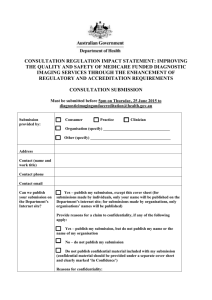
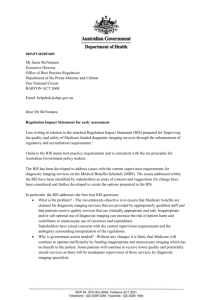
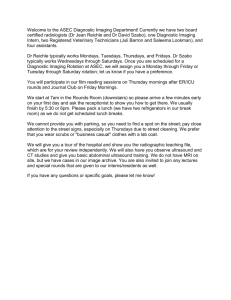
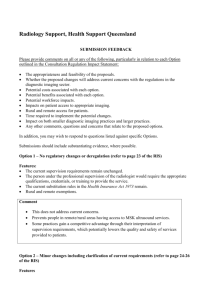
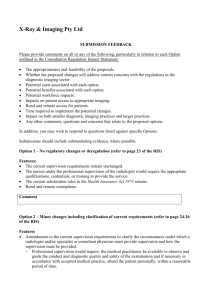


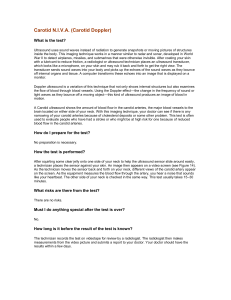

![Jiye Jin-2014[1].3.17](http://s2.studylib.net/store/data/005485437_1-38483f116d2f44a767f9ba4fa894c894-300x300.png)

